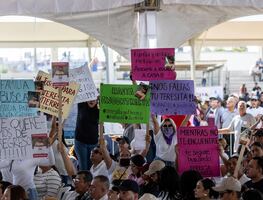Más Información

Osiel Cárdenas, exlíder del Cártel del Golfo, recibe auto de formal prisión; enfrentará juicio por homicidio

Jóvenes mexicanos pasan más de 2 mil horas al año en el teléfono; OCDE alerta sobre su impacto en la salud mental

Sergio Gutiérrez Luna destaca aprobación de 25 reformas en la 66 Legislatura; "Un logro histórico para la 4T", señala

Secretario de Agricultura reafirma defensa del maíz blanco; "Seguiremos apoyando la producción nacional no transgénica", afirma

¿Maíz transgénero? Rubén Rocha corrige desliz durante discurso en Sinaloa; destaca importancia del maíz blanco

Sheinbaum asegura apoyo total a Sinaloa para enfrentar violencia; "Nunca los vamos a dejar solos, aquí está la presidenta"
Devora Oviedo
is focused on the 500 threads in her loom, Her fingers count each while her lips barely move. She almost never misplaces the sea creatures , which she learned by memory as she has never used a pattern.
She has become a loom expert after 40 years using it. She is one of the few women left who still work with the loom in San Mateo del Mar , a town located between the ocean and a lagoon.
Devora is 59 years old and she's one of the 80 Huave , or Ikot , women who rescued this art . She began weaving when she was 13 years old.
Devora
is also one of the few artisans who dyes her cotton threads with natural materials such as mahogany tree bark.
Despite still using the traditional dying techniques , Devora has diversified her designs . She began by making napkins, then huipiles , and shawls but now she also makes bags, tablecloths, wallets, phone cases , pants, shirts, and even coasters.
The forgotten craft
Cotton loom
was getting lost in this community in southern Oaxaca until the Commission for the Development of Indigenous People (CDI) set its eyes on the few families that still practiced it and offered them support to open market niches outside the region. The strategy was successful and now over 80 women make a living through the loom .
Devora
was one of the women who promoted the use of the waist loom . Over 50 years ago, she created a cooperative society along with other 19 women, called Monjüey Mandel.
In time, the number of members decreased because of the scarce sales but 10 years ago, the sale of their clothes increased in the national market.
Now, Devora 's daughters, nieces, and granddaughters are weavers and part of the cooperative . They have been invited to participate in art fairs in Oaxaca and all over Mexico and now have their own brand, which helped them get better prices .
Devora
explains that since they have their own brand they sell their products themselves and get better profits and that many people look for them to ask them to make custom pieces. “Now we set the prices. Now it's a business that helps us make a good living.”
Embracing men
San Mateo del Mar
abides by traditions . Its language is considered as an orphan as it has no relation to any other tongue. Here, women are dedicated to selling sea products and were allowed to vote 10 years ago.
Half the women in the community, around 7,000 women, live in poverty , and the waist loom represents a well-paid employment opportunity for them.
To weave , women sit down in small chairs in their backyards and to keep their the loom firm they place it on their waist. That's how Ofelia and Romualda do it every day, from 5 a.m. to 8 p.m. but if they have requests, they finish working at 1 a.m.
If they worked for 8 hours a day, each of these women would finish a huipil in a month, and a month and a half to finish a shawl .
In Ofelia Gijón 's home, women aren't the only ones who work on the waist loom , her brother and his sons do too.
In the face of the lack of jobs in the town and the scarce sea products , many men decided to work on this trade , which was reserved for women , especially after the 2017 earthquake .
“In my family , in the beginning, only women weaved because that's how it has always been, but then there was a drought and there was no water in the lagoon , there was very little fishing , and then the earthquake destroyed us. Some men decided to lend a hand in the weaving, in the face of the increased demand for their products outside the region, since San Mateo was one of the damaged towns, they paid a lot of attention to the artisans and the sales rocketed,” says Ofelia .
Ofelia explains that 70% of their creations are sold in the city of Oaxaca and Mexico City.
Inspired by the sea
The Huave is an ethnicity that revolves around the sea and they usually reproduce sea elements such as fish, shrimp, crabs, sea snails, dolphins, turtles, and even mermaids in their pieces but they also incorporate Pre-Hispanic motives, animals, stars , and flowers .
gm





